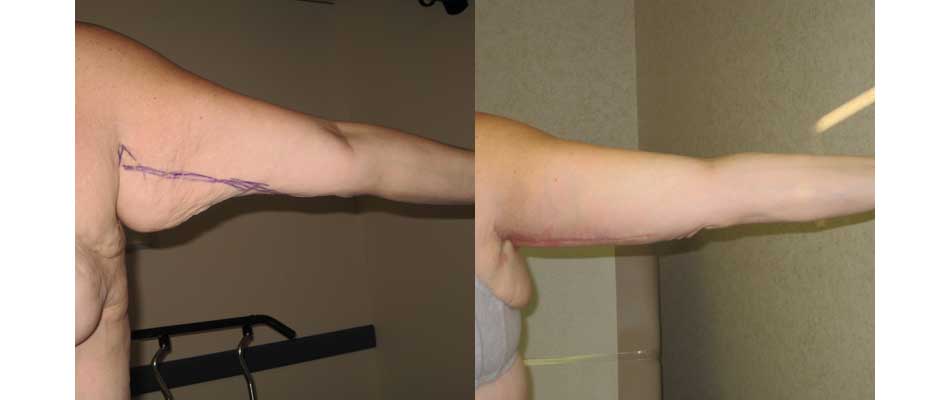Arm Lift (Brachioplasty)
Do you find that no matter how much you diet and exercise, your arms don’t look how you want them to? Aging, weight fluctuations, and genetics can cause arms to appear to droop and sag, making you feel self-conscious or unattractive.
If you want younger, more toned arms, an arm lift in Barrington by Dr. Madry may be the answer. Arms can look slimmer and more athletic after an outpatient procedure with a short recovery period.
What is an arm lift?
Arm lift surgery, also called brachioplasty, is a cosmetic surgical procedure to reshape the underside of the upper arm. Sometimes, liposuction is used during brachioplasty to remove excess fat. The result is a more toned and contoured arm that is more proportionate to the rest of your body.
Diet and exercise may firm the arm’s underlying muscle but can’t firm and tone skin if it’s lost elasticity. If you feel like your arms just aren’t as toned and young-looking as you feel, a brachioplasty can:
- Remove baggy excess skin
- Smooth and tighten the shape of the upper arm
- Reduce fat pockets in the upper arm
- Boost your self-confidence
How is Brachioplasty performed
At your consultation, you’ll have a physical exam and talk about your health history, the procedure, and any questions you have. You may also need:
- An ECG
- Lab work
- X-rays
Before your surgery date, you may need to quit smoking and temporarily stop or adjust some medications.
- Your surgeon will mark the locations of the intended incisions on your arms.
- You may have general anesthesia or sedation. You will need someone with you who can drive you home.
- Your surgeon will remove excess tissue and fat through the incisions and then reshape the remaining tissue.
- Excess skin will be removed, and then the skin will be pulled back into place.
- Your incisions will be closed with stitches.
- You may temporarily have a drainage tube in your arm and may need to wear a compression sleeve to control swelling.
- You will rest in a recovery area until you are cleared to go home.
Overall, the procedure should last two to three hours.
Recovery from Brachioplasty
You’ll need help at home for the first day or two.
You will likely need to wear a compression sleeve while you recover. Your post-operative instructions will tell you how to take care of your incisions, symptoms that might indicate an infection, the date of your follow-up appointment, and other information that is important to your healing. It’s critical to follow your post-operative instructions carefully for the best possible results.
Most people can return to work and most activities in about two weeks. You should be ready to return to all your normal activities within six weeks.
Patients often ask about the brachioplasty scar. Because of the incisions needed to access the extra tissue and remove excess skin, a typical brachioplasty scar can be difficult to hide. It can run from armpit to elbow. A short-scar brachioplasty may be possible in some patients with minimal loose skin that is primarily just below the armpit with good skin tone.
Scars, long or short, heal and fade best when protected from sun exposure.
Who is a good candidate for brachioplasty?
Brachioplasty isn’t right for everybody. While brachioplasty is typically safe, the best candidate is someone:
- With significant loose upper arm tissue
- In overall good health
- At a stable weight
- Who is a nonsmoker
- Not on long-term oral steroids
- Has no history of connective tissue disorders, like Ehlers-Danlos syndrome
- Has realistic expectations about what brachioplasty can do
- Has no significant health issues
Risks of brachioplasty
Every surgery comes with some risk. Complications of brachioplasty may include:
- Asymmetry in your arms
- Bleeding
- Infection
- Pain
- Reactions to anesthesia
- Scarring
- Stitches that don’t stay put
- Temporary numbness, changes in sensation
- Tissue damage
How much does brachioplasty cost?
Most insurance plans don’t cover cosmetic procedures. The typical cost of brachioplasty varies by surgeon and is based on:
- The type of procedure used
- The skill and experience of your surgeon
- Geographic location
- Medical tests required
- Anesthesia
- Operating room costs
- Surgeon’s fee
- Prescriptions
- Compression garments for after surgery
Cost is an important factor for most people, but it’s essential to choose a surgeon you feel comfortable with when you’re deciding on plastic surgery. You’ll feel more at ease when you know you can trust your surgeon.
If your arms make you look old and feel embarrassed, call to schedule a free arm lift consultation today.



